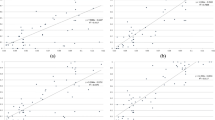Abstract
In a population intended for breeding and selection, questions of interest relative to a specific segregating QTL are the variance it generates in the population, and the number and effects of its alleles. One approach to address these questions is to extract several inbreds from the population and use them to generate multiple map** families. Given random sampling of parents, sampling strategy may be an important factor determining the power of the analysis and its accuracy in estimating QTL variance and allelic number. We describe appropriate multiple-family QTL map** methodology and apply it to simulated data sets to determine optimal sampling strategies in terms of family number versus family size. Genomes were simulated with seven chromosomes, on which 107 markers and six QTL were distributed. The total heritability was 0.60. Two to ten alleles were segregating at each QTL. Sampling strategies ranged from sampling two inbreds and generating a single family of 600 progeny to sampling 40 inbreds and generating 40 families of 15 progeny each. Strategies involving only one to five families were subject to variation due to the sampling of inbred parents. For QTL where more than two alleles were segregating, these strategies did not sample QTL alleles representative of the original population. Conversely, strategies involving 30 or more parents were subject to variation due to sampling of QTL genotypes within the small families obtained. Given these constraints, greatest QTL detection power was obtained for strategies involving five to ten map** families. The most accurate estimation of the variance generated by the QTL, however, was obtained with strategies involving 20 or more families. Finally, strategies with an intermediate number of families best estimated the number of QTL alleles. We conclude that no overall optimal sampling strategy exists but that the strategy adopted must depend on the objective.







Similar content being viewed by others
References
Gilks WR, Richardson S, Spiegelhalter DJ (1996) Introducing Markov chain Monte Carlo. In: Gilks WR, Richardson S, Spiegelhalter, DJ (eds) Markov chain Monte Carlo in practice. Chapman and Hall, London, pp 1–19
Jannink JL, Jansen RC (2001) Map** epistatic QTL with one-dimensional genome searches. Genetics 157:445–454
Jannink JL, Wu XL (2003) Estimating allelic number and identity in state of QTL in interconnected families. Genet Res 81:133–144
Jansen RC, Jannink JL, Beavis WD (2003) Map** quantitative trait loci in plant breeding populations: use of parental haplotype sharing. Crop Sci 43:829–834
Lander ES, Botstein D (1989) Map** Mendelian factors underlying quantitative traits using RFLP maps. Genetics 121:185–199
Liu Y, Zeng ZB (2000) A general mixture model approach for map** quantitative trait loci from diverse cross designs involving multiple inbred lines. Genet Res 75:345–355
Muranty H (1996) Power of tests for quantitative trait loci detection using full-sib families in different schemes. Heredity 76:156–165
Qi X, Stam P, Lindhout P (1996) Comparison and integration of four barley genetic maps. Genome 39:379–394
Rao S, Li X (2000) Strategies for genetic map** of categorical traits. Genetica 109:183–97
Rebaï A, Goffinet B (1993) Power of tests of QTL detection using replicated progenies derived from a diallel cross. Theor Appl Genet 86:1014–1022
Rebaï A, Goffinet B (2000) More about quantitative trait locus map** with diallel designs. Genet Res 75:243–247
Rebaï8 A, Goffinet B, Mangin B, Perret D (1994) Detecting QTLs with diallel schemes. In: van Ooijen JW, Jansen J (eds) Biometrics in plant breeding: applications of molecular markers, 9th meeting of the EUCARPIA, Wageningen, The Netherlands, 1994. CPRO-DLO, pp 170–177
Sillanpää MJ, Arjas E (1998) Bayesian map** of multiple quantitative trait loci from incomplete inbred line cross data. Genetics 148:1373–1388
** quantitative trait loci using the identical by descent-based variance component method. Genetics 149:1139–1146
Xu S (1998) Map** quantitative trait loci using multiple families of line crosses. Genetics 148:517–524
Acknowledgements
This research was funded by USDA-NRI, CSREES Project Award No. 2001-35301-10848 and supported by the Hatch Act and the State of Iowa.
Author information
Authors and Affiliations
Corresponding author
Additional information
Communicated by P. Langridge
Rights and permissions
About this article
Cite this article
Wu, XL., Jannink, JL. Optimal sampling of a population to determine QTL location, variance, and allelic number. Theor Appl Genet 108, 1434–1442 (2004). https://doi.org/10.1007/s00122-003-1569-5
Received:
Accepted:
Published:
Issue Date:
DOI: https://doi.org/10.1007/s00122-003-1569-5




